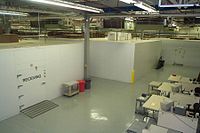
Photo from wikipedia
Background To assess the vitamin D nutritional status, serum total 25-hydroxyvitamin D (25(OH)D) concentration is measured. We used six automated 25(OH)D immunoassays (AIAs) available in Japan and certified by the… Click to show full abstract
Background To assess the vitamin D nutritional status, serum total 25-hydroxyvitamin D (25(OH)D) concentration is measured. We used six automated 25(OH)D immunoassays (AIAs) available in Japan and certified by the Vitamin D Standardization Program (VDSP) at the U.S. Center for Disease Control and Prevention to assess the concordance of the assay results. Methods Serum total 25(OH)D concentrations in SRM 972a and 20 serum samples from patients were determined using three liquid chromatography-tandem mass spectrometry (LC-MS/MS) and six AIAs (pilot study), and an additional 110 serum samples were assessed by the six AIAs (surveillance study). The assay bias from the results of LC-MS/MS by Chiba University or consensus values (i.e. average of six AIAs) was estimated using the procedure described in CLSI document EP09-A3. Results LC-MS/MS at Chiba University could completely separate 25(OH)D2, 25(OH)D3 and 3-epi-25(OH)D3, and the observed values including total 25(OH)D in SRM 972a were all within ±1·SD of the assigned values. All AIAs produced results greater than ±3·SD. In the pilot study, four of the six AIAs had an average percentage bias, as estimated by confidence interval (CI), larger than ±5% (acceptance criterion in CLSI); the bias converged from −6.5% to 3.2% after adjustment by LC-MS/MS. In the surveillance study, 25(OH)D concentrations in AIAs all adjusted to LC-MS/MS converged within ±5% from consensus values. However, some AIAs showed negative or positive bias from the consensus values. Conclusions Current AIAs in Japan continue to lack standardization. Manufacturers should implement quality assurance strategies so that their values more closely align to those of standard reference material 972a.
Journal Title: Annals of Clinical Biochemistry
Year Published: 2018
Link to full text (if available)
Share on Social Media: Sign Up to like & get
recommendations!